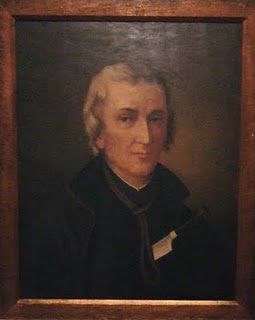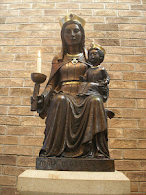On 13th January 1679, Jesuit priest, Fr David Lewis (alias Charles Baker) was transferred from Monmouth Gaol to the Gaol at Usk, ‘The Old Bridewell’ or ‘House of Correction’. This was on the north side of Bridge Street and, at that time, many of the Catholics to whom Fr Lewis ministered were also incarcerated at Usk for refusing the Oaths of Allegiance and Supremacy. Ironically, this Old Bridewell had originally been a Friary, a house of the Grey Friars. The first two photos show the site of the old Gaol.




This group of photographs shows:
1) The Catholic Church of St David Lewis and St Francis Xavier which is opposite Porth-Y-Carne House. The church was originally dedicated to St Francis Xavier but in 1974 it was rededicated and now honours the Jesuit who was martyred near the spot in 1679.
2 & 3) The broken and cracked gravestone, believed to be the original, which was removed from the Saint’s grave at Usk Priory Church. This old stone is outside and to the right of the Catholic Church.
4, 5 & 6) Inside the Catholic Church, an explanatory notice, the Martyr’s Shrine and the colourful, modern stained glass window depicting the church’s two Jesuit patrons, St Francis Xavier and St David Lewis.






The Jesuit’s body was taken in procession to Usk’s Priory Church of St Mary and respectfully buried in the churchyard. His grave is the one nearest the door of the west porch and just to the left of the path as you approach the church. The stone marking the grave is relatively new, having been placed there after the canonisation of St David Lewis. It replaces an old and broken stone generally believed to be the original gravestone. The Priory Church West porch and the Martyr’s gravestone are in the next photographs.

 In Penal Times, Mass was celebrated whenever and wherever possible. This could mean in a private house, an inn, a barn, in a field, or in the woods. After the execution of Fr David Lewis in 1679, a house in Usk where he used to say Mass was confiscated. The popular Pub, Cross Keys, is thought to be that house. It is located on Bridge Street, not far from the site of the former Usk Gaol.
In Penal Times, Mass was celebrated whenever and wherever possible. This could mean in a private house, an inn, a barn, in a field, or in the woods. After the execution of Fr David Lewis in 1679, a house in Usk where he used to say Mass was confiscated. The popular Pub, Cross Keys, is thought to be that house. It is located on Bridge Street, not far from the site of the former Usk Gaol. 






















.JPG)

.JPG)



.JPG)
